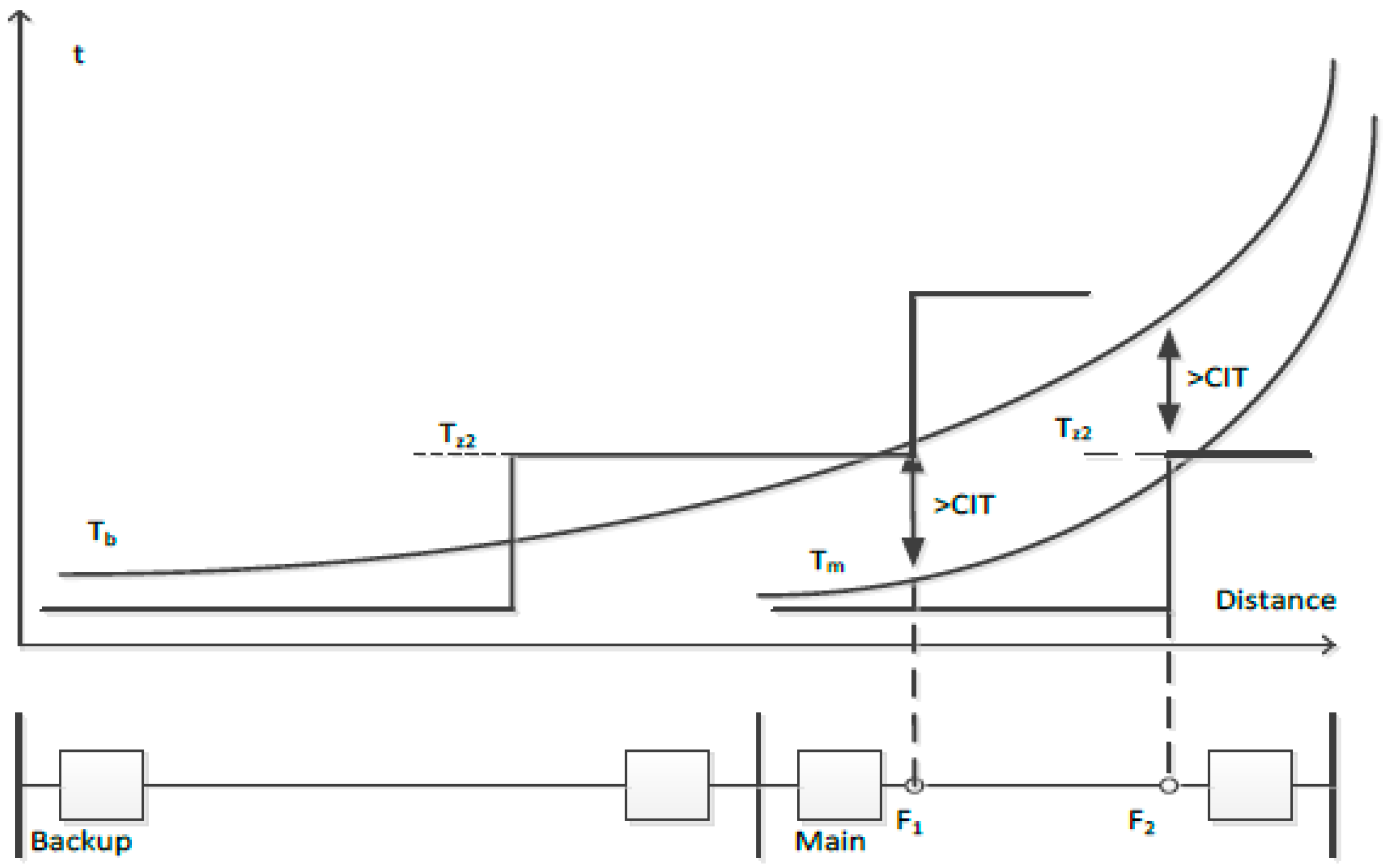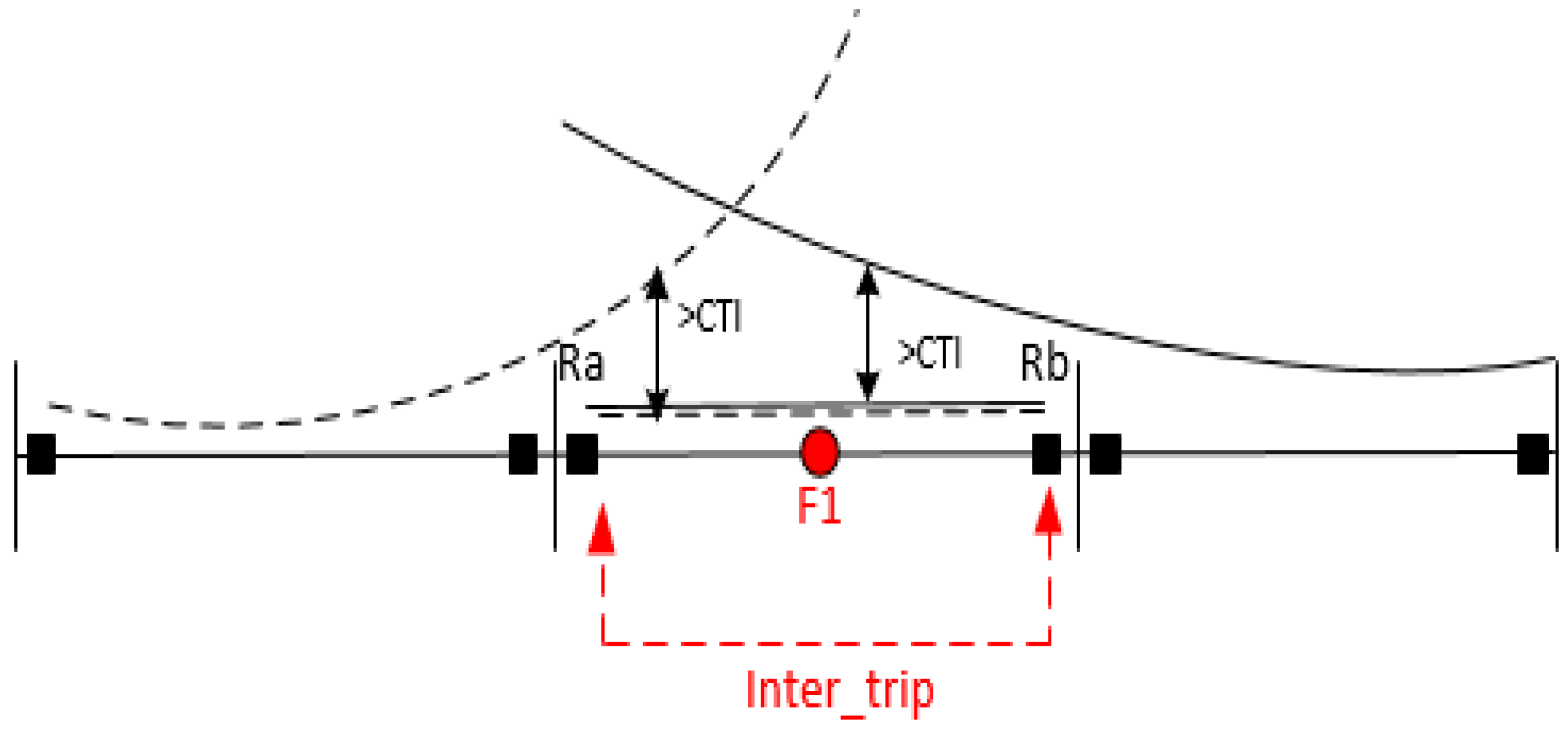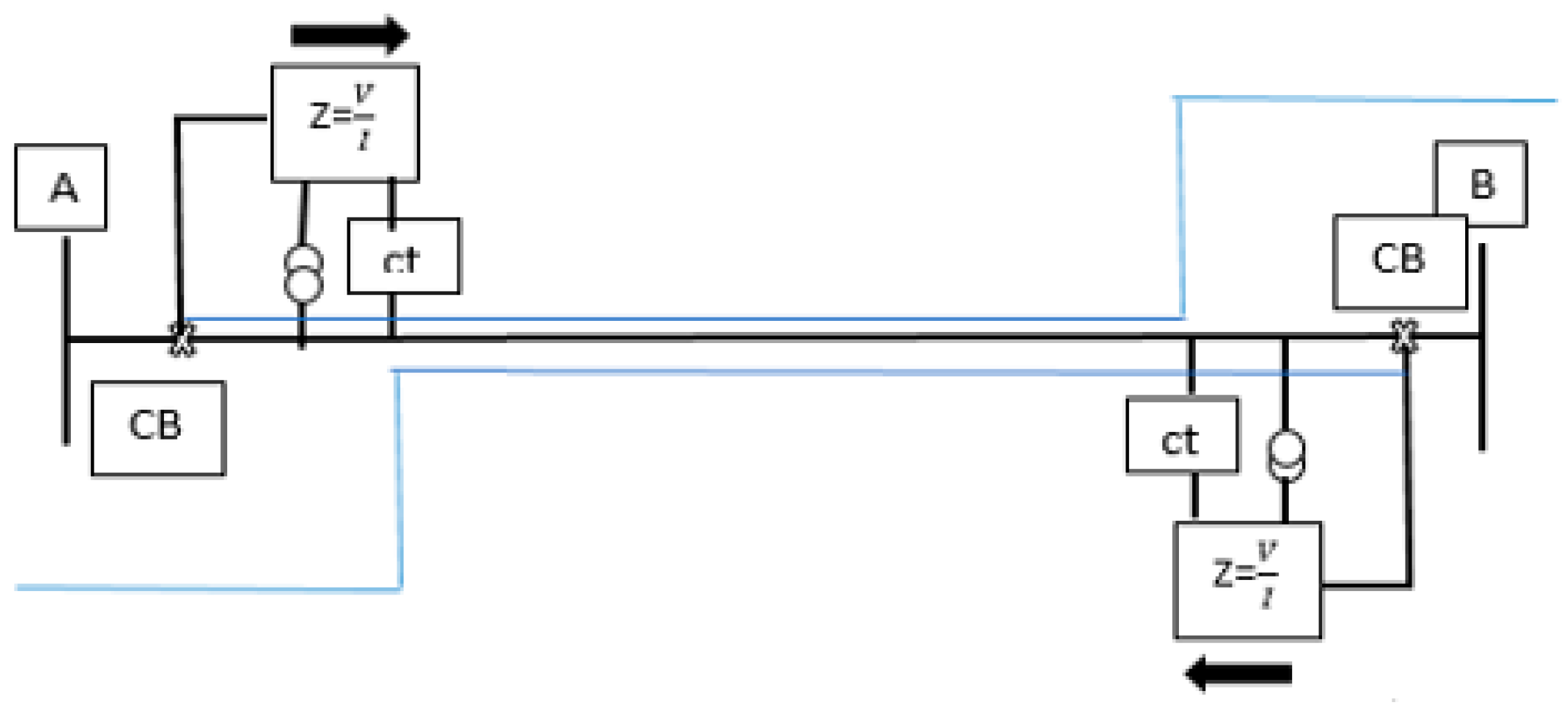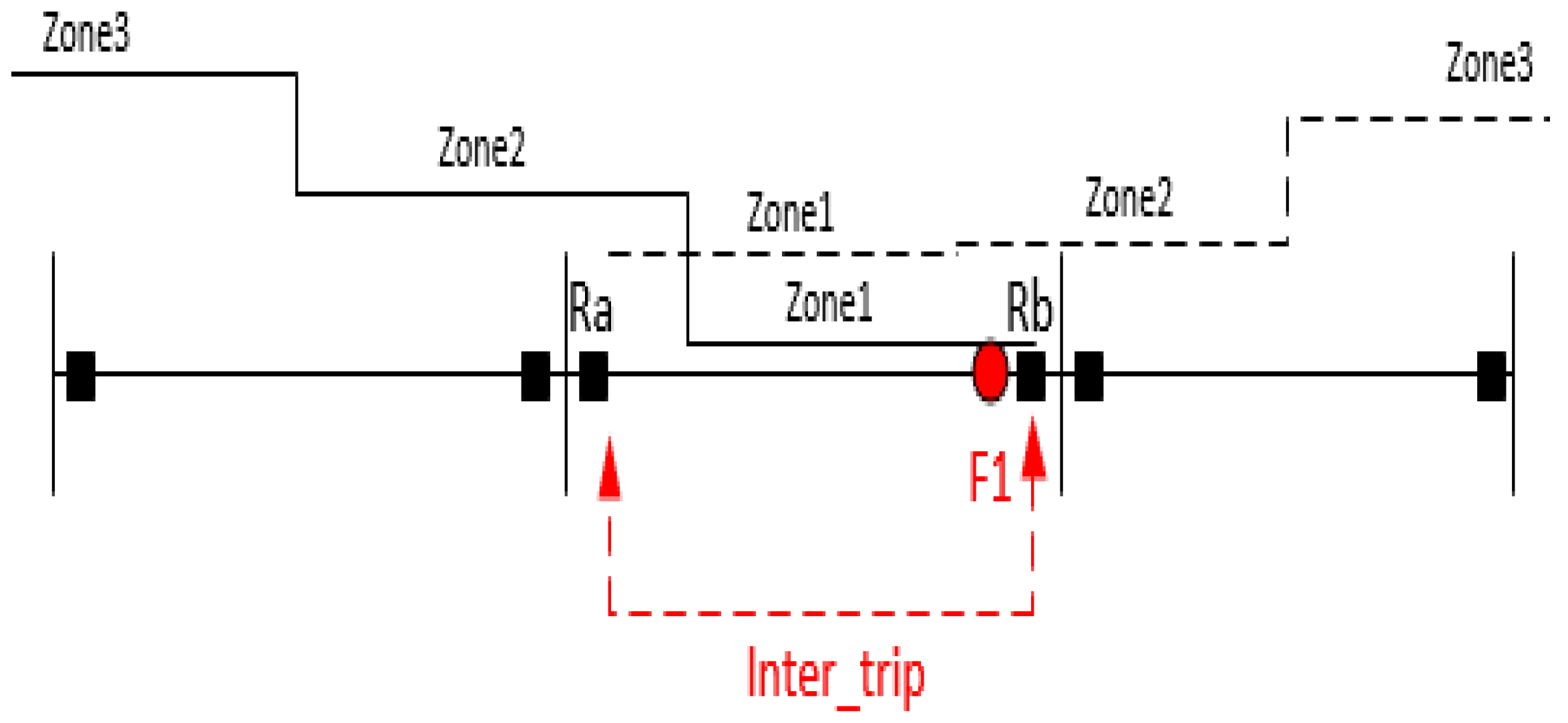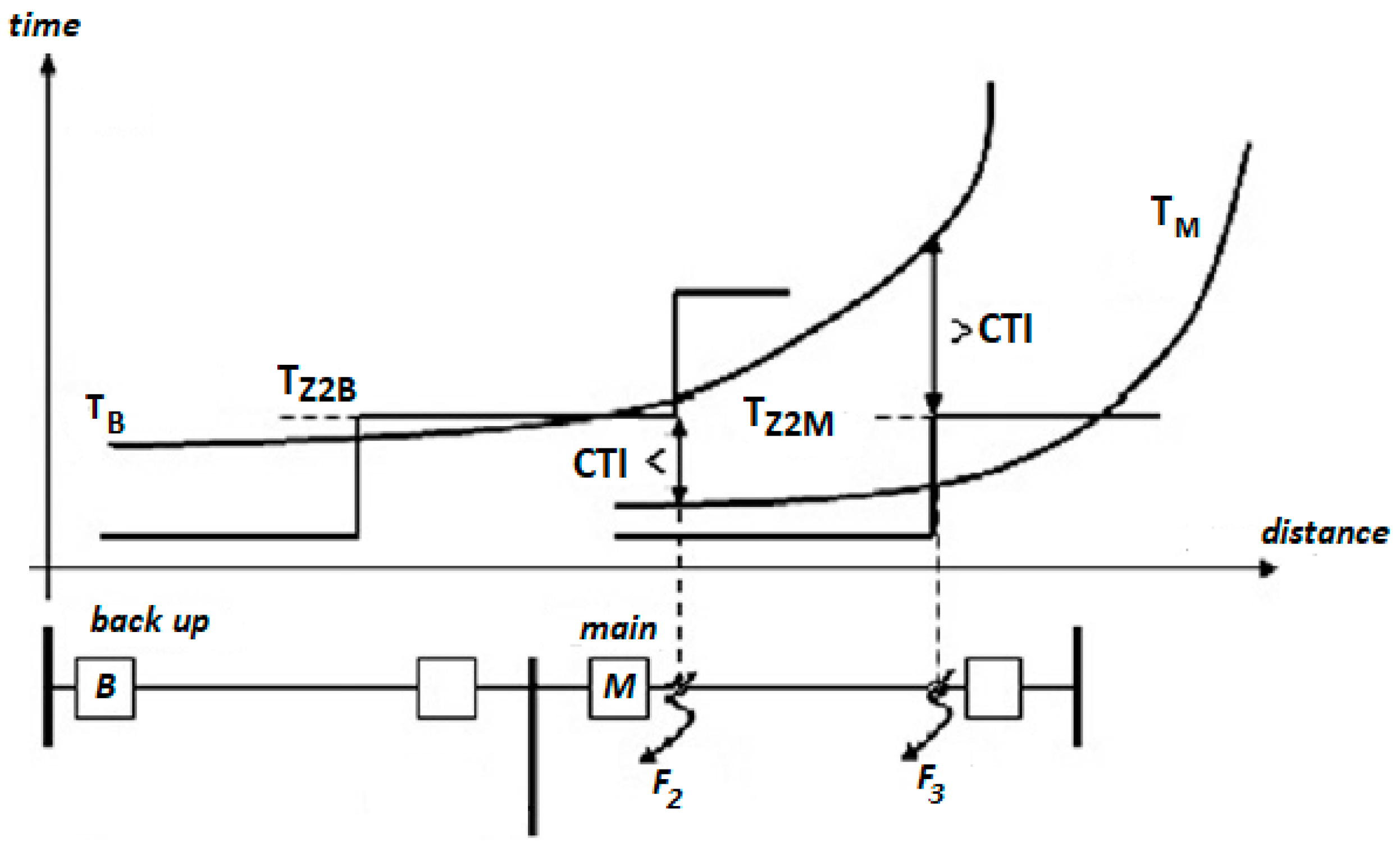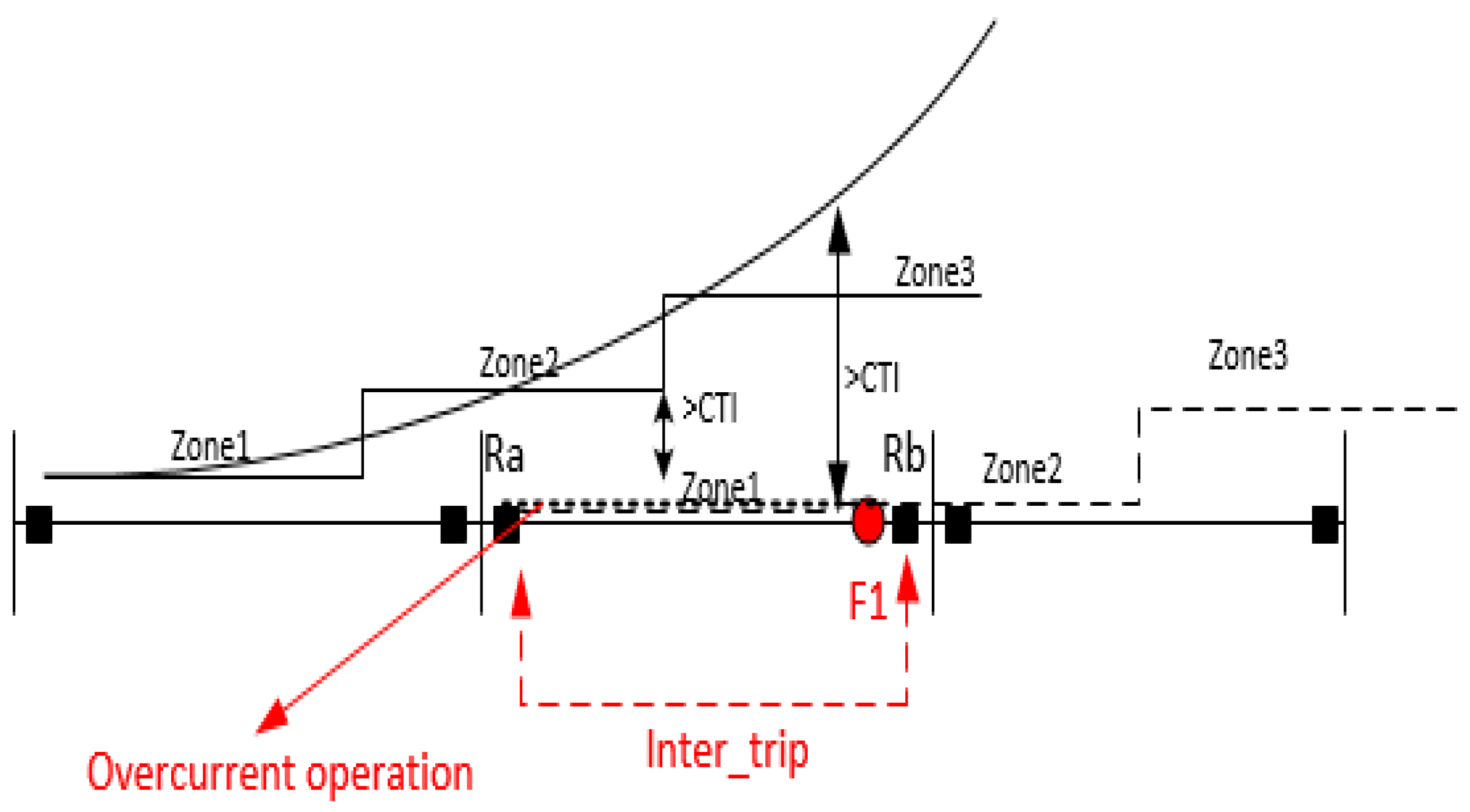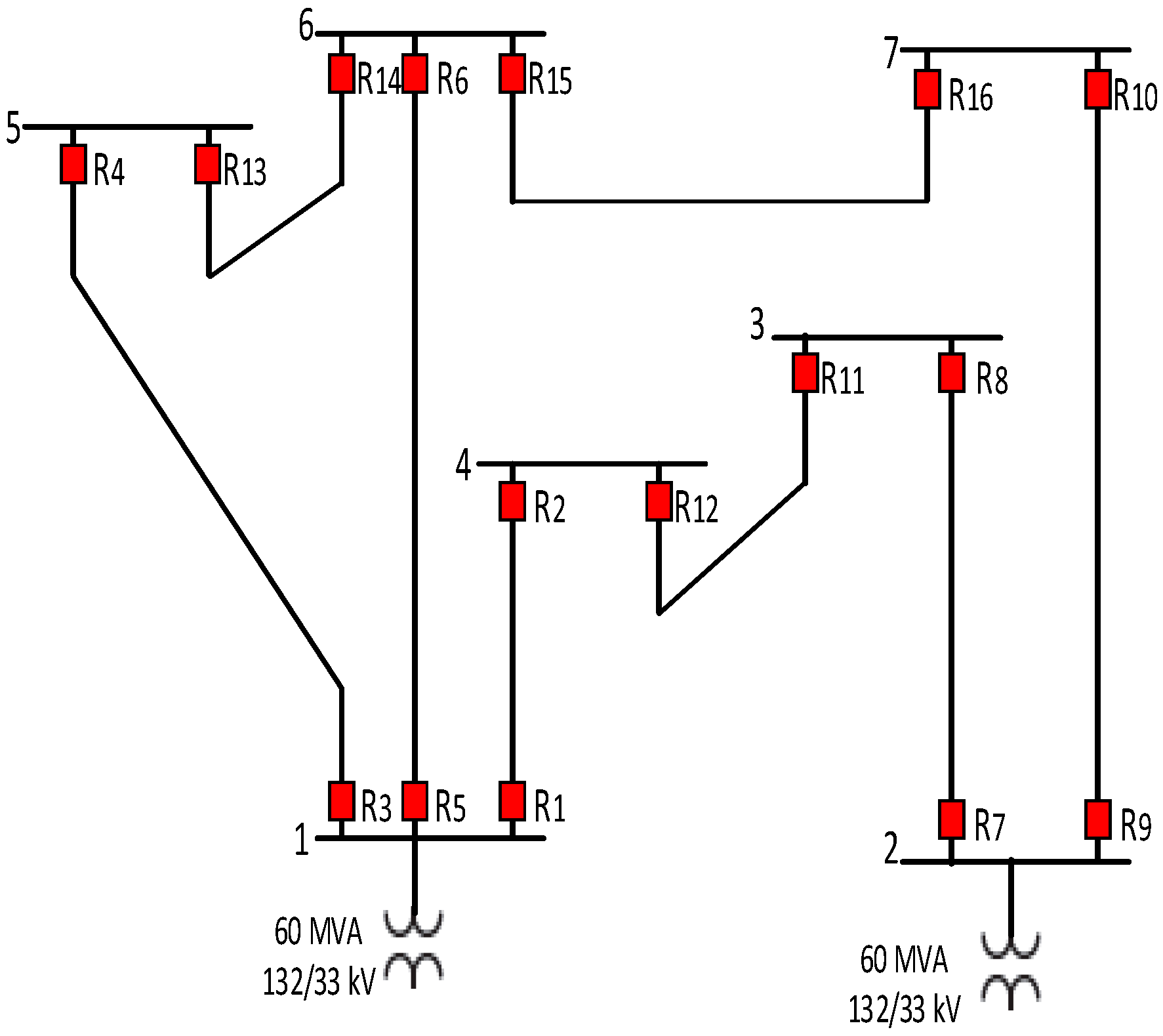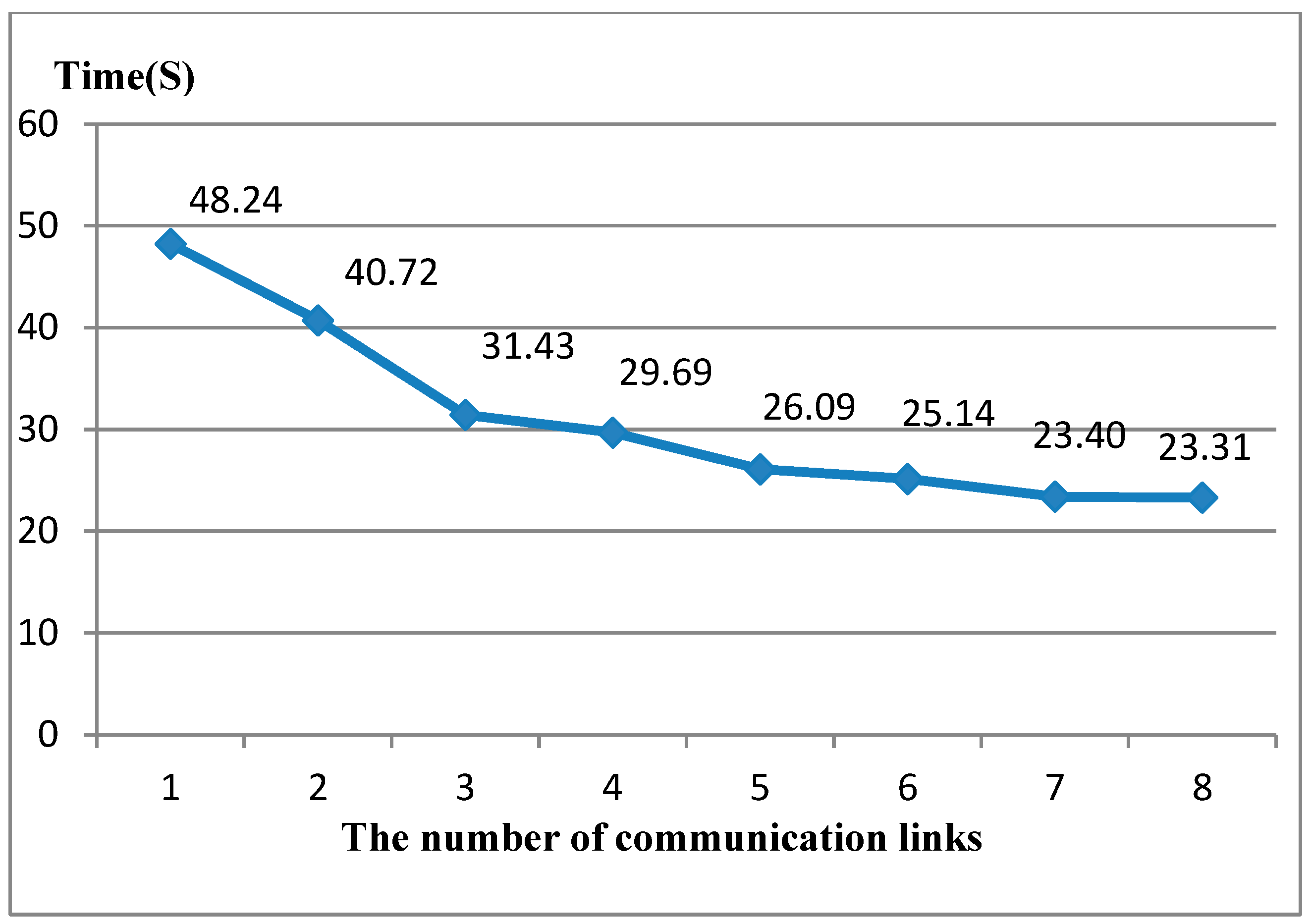1. Introduction
An error in the power system is unacceptable speed. In case of an error, the task of the system is to isolate the error from the rest of the system as soon as possible [
1]. A protection system consists of relay units, current- and voltage-measuring transformers and a power switch. With the help of measuring transformers, the current and voltage of the power system are reduced to the permissible values of the relay operation. Relays are considered the main and intelligent part of a protection system, which are responsible for detecting abnormal conditions (error detection) [
2,
3]. After detecting this condition, the faulted part is isolated by sending a signal to the power switch. An efficient protection system should have features such as reliability, speed and selectivity. In power networks, the use of reliable, fast and uninterrupted protection systems reduces downtime and increases network reliability. Various communication links, such as those between relays, are used to improve the performance of the protection system (uninterrupted and fast operation to fix the fault). Any management and control for this structure require requirements and access to some parallel infrastructures. One of the most important of them is the existence of reliable platforms in infrastructure communications. Currently, and according to the progress in the communication infrastructure, protection plans equipped with communication systems between relays have been considered [
4]. The aim [
5] is to solve the problem of optimal coordination of overcurrent relays with respect to the transient fault current of the wind turbine. These currents can change the operation time of the relays and eventually cause inconsistency between the main and backup relays. This article aims to present a method based on the dynamic modeling of overcurrent relay with regard to the effect of the transient fault current of wind turbines. In this reference, the difference between the actual fault currents and the transient state is stated first and then the coordination of the overcurrent relays to reduce the operation time of the main relays with the help of three variables (the current adjustment factor, the time adjustment factor and the type of relay characteristic).
In [
6], a method for network protection using the voltage measurement of the relay installation site is presented. Based on this, a new characteristic has been created for relays, depending on the measured voltage of the place of installation of the relay. Adding this parameter to the mathematical relation of the operation time of overcurrent relays creates a suitable flexibility to adjust and reduce their operation time. The proposed method has been evaluated for the different sizes and places of installation of the distributed generation sources, error conditions and different scenarios. In this method, the communication channel is not used, and the operation time of the relays is low only by considering the fault voltage of the relay installation location in both operating modes (connected to the network and islanded). The optimization algorithm has been improved to solve the problem of the optimal coordination of overcurrent relays in [
7]. In this algorithm, each of the particles represents a solution for the proposed problem and includes the settings of each of the relays. Normally, in this algorithm, the amount of particles is based on creating a random number with a uniform distribution between zero and one; while in the improved algorithm, this is achieved based on the normal distribution. In [
8], the coordination between these relays has been improved. In case of a line error, the distance relay works first. However, if this relay cannot function properly, the support directional overcurrent relay provided for it shall function. The main innovation of this article includes (1) considering the operation time of the second zone as a variable and (2) including the characteristic curve that can be changed by the user for directional overcurrent relays. By using the characteristics that the user can change, the operation time of the overcurrent relays can be determined more optimally, and therefore, better coordination can be created between it and the distance relay. In the proposed design [
9], an inverted dual characteristic curve is used for overcurrent relays when they are in series and operate in only one direction. These characteristics simplify the complexity of the problem and create higher flexibility in the process of the optimal coordination of relays. By using these characteristics, a total of five variables, i.e., the variables of the current and time adjustment coefficient of the relay have been created for each of the characteristics and the setting of the second zone of the distance relay. The sine–cosine optimization algorithm has been used to determine the optimal values of these variables. The simulation and analysis results of this method on different networks show that the proposed method has been able to eliminate the inconsistency between the overcurrent and distance relays and reduce the operation time of the relays.
The directional and distance overcurrent relays have been optimally coordinated using the ant’s optimization algorithm in [
10]. Here, the optimal coordination problem between these relays is formulated as a complex non-linear problem in which the continuous variables, such as the time adjustment coefficient of the overcurrent relay and the operation time adjustment of the distance relay, and the discrete variable, such as the current adjustment coefficient of the overcurrent relay, are included. The main innovation of this article can be considered only as solving the problem with the optimization algorithm of ants and combining it with the linear programming algorithm. In [
11], a general objective function is presented to find the optimal settings of overcurrent and distance relays to coordinate them better. This objective function is expressed in such a way that the negative time difference between the main and backup relays (in other words, the operation of the backup overcurrent relay ahead of the main relay) is eliminated. In the proposed method, not only is the number of inconsistencies between overcurrent and distance relays greatly reduced, but also the difference in their operation time is minimized. The variables under investigation in this article include the current adjustment coefficients and the time of the overcurrent relay along with the determination of its characteristic curve type as well as the operation time of the second zone of the distance relay. To solve this problem, two genetic algorithms and an optimization algorithm based on human behavior have been used. One of the most common faults in the power system is the phase-to-ground fault. The intensity and size of this fault current depend on the type of grounding. In [
12], a method is presented to improve the optimal coordination of overcurrent relays, in which phase and phase-to-ground errors are considered. Here, a new objective function is proposed for the problem of optimal coordination of overcurrent relays, which combines the operation time of overcurrent relays with phase characteristics and phase to ground. In the proposed method of this article, each of the overcurrent relays is equipped with two characteristics, that is, the characteristic of determining phase and phase-to-ground errors. By coordinating between the two phase characteristics of the main and backup relays, the occurrence of phase errors can be detected quickly. In [
13], he used the non-standard characteristic curve to coordinate between overcurrent and distance relays. In this design, the constant parameters of the characteristic curve are introduced as the new variables for setting the overcurrent relays. In some cases, the fault current passing through the overcurrent relay can be lower than its maximum setting current and lose the sensitivity of overcurrent relays. In [
14], a robust method for optimal setting of overcurrent relays in distribution networks has been presented. In this article, uncertainties such as network operating conditions, fault type, fault impedance, fault of current transformer measuring equipment and disconnection and connection of distributed generation units are considered. In the proposed method of this article, a characteristic curve proposed in [
15] is used, in which instead of two variables in the mathematical relationship of the relay, four variables are used (conversion of fixed parameters into variables). In [
16], an interval method has been used to model uncertainties in the problem of the optimal coordination of relays. In [
17], a new formulation is presented for the optimal coordination of overcurrent and distance relays in the presence of series compensation. The network compensator in normal operation mode works similar to a capacitor bank. However, during the occurrence of the fault, this compensator has a little capacitive property to reduce the fault current. In [
18], chaos addresses energy in networks of electrical oscillators studied.
In this article, the use of distance relays is suggested in these cases. The problem proposed here is solved with the help of the optimization algorithm, and its results are compared with that of the genetic algorithm. This comparison shows the very good accuracy of the weeding algorithm in solving the problem. The proposed method has also been able to reduce the number of inconsistencies between the overcurrent and distance relays. The overcurrent and distance relays protect the above distribution lines. Usually, in these protection plans, the main protection is with the help of distance relays and the backup protection with overcurrent relays. Therefore, the coordination between these two relays is very important. In this article, a plan is presented for the optimal coordination of distance relays and directional overcurrent relays in the super distribution network with the help of communication links. In this design, the overcurrent relays on both sides of the line are equipped with communication links with instant function, and as soon as the fault is detected, they signal each other to remove the faulty part in the shortest possible time. In the proposed plan, the location and number of this plan have been determined such that the maximum speed of operation in the protection system can be achieved with the least number of communication links. The problem of coordinating the overcurrent and distance relays in the presence of these communication links is a very huge and complex problem, which is solved by combining the genetic optimization and linear programming algorithms. With the genetic algorithm, the installation location and the setting of the operation time of the second zone of the distance relay are determined, and with the linear programming algorithm, the setting of the operation time of the overcurrent relays is determined. In this way, the main focus of this article is on the following:
Solving the problem of optimal coordination of overcurrent and distance relays in the presence of communication links;
Determining the location and the minimum required number of installation of communication links in order to reduce the operation time of overcurrent and distance relays;
Formulating for the proposed problem of coordination of distance and overcurrent relays in the presence of communication links.
The following is the structure of the article:
In
Section 2, the coordination of overcurrent and distance relays are presented. In
Section 3, the effect of a communication link on the coordinated performance of overcurrent relays is discussed.
Section 4 looks at using a communication link in distance relays. In
Section 5, the effect of using a communication link on the coordinated performance of distance relays is discussed.
Section 6 has the formulation of the proposed.
Section 7 discusses the study system and result, and finally, some conclusions will be drawn from the article.
5. The Effect of Using a Communication Link on the Coordinated Performance of Distance Relays
As mentioned earlier, the second zone of the distance relays acts as a cover to protect the main line. The operation time of this zone is with a time delay compared to the instantaneous operation of the first relay zone. According to
Figure 4, by using the communication link for the distance relays on both sides of the line, if an error occurs at point F1 (within the first zone of the distance relay R
b and within the second zone of the R
a relay), the R
b relay will act instantaneously. Then, it signals the R
a relay so that this relay also operates quickly and does not wait for the time delay of the second relay area. In this case, the R
a relay, which previously operated with a time delay, will function with the minimum possible time by adding a communication link.
Therefore, in this situation, the second area of the distance relay, which is installed on the line with a communication link, will function with a minimum time delay, so the addition of this communication link will reduce the operation time of the distance relays.
6. The Proposed Method
According to
Figure 5, to F2 and F3 faults in the line, first, the main and backup relays must be coordinated. This means that the operation time of the backup relays must always be greater than that of the main network relays by the CTI. Secondly, the overcurrent relay should also be coordinated with the operation time of different areas of the distance relay. The operation time of the first zone of the distance relay is instantaneous and works much earlier than the backup overcurrent relays. With this second zone of the distance relay as the main protection, it should have a smaller volume than the backup overcurrent relay.
As seen in the above figure, a distance relay and an overcurrent relay are installed on each side of the lines. The main relays are shown with the letter M and the backup relays with B. To establish this coordination, if a fault occurs at point F3 (the end of the first zone of the distance relay M), the operation time of the zone of the distance relay M must be earlier than that of the overcurrent relay B. For F2 error (the end of the second zone of the backup distance relay B) also, the relays must be set in such a way that the main overcurrent relay M operates first, and if it fails, then the second zone of the backup distance relay operates.
According to the above explanations, establishing coordination between relays has the following three limitations:
The first condition is related to the optimal coordination of the main and backup overcurrent relays in case of an error in the entire length of the line. The second condition is to ensure coordination between the overcurrent and distance relays in case of an error at the beginning of the second zone of the main distance relay. In this regard, they represent the operation time of the overcurrent relay and that of the second zone of the distance relay, respectively. The third condition is to coordinate between the distance and overcurrent relays for the occurrence of an error at the beginning of the first zone of the main distance relay. In this regard, it is the operation time of the second zone of the backup distance relay and that of the main overcurrent relay.
Figure 6 shows how to coordinate between the distance and overcurrent relays in the presence of a communication link. As the operation time of the overcurrent relays on both sides of the line will be equal to the fixed value with the use of communication links, the coordination relation (4) and (5) will be rewritten as the relation (7) and (8) below:
On the other hand, the operation time of the second zone of the linear distance relay, which is equipped with a communication link, has also been reduced, so instead of Equation (6), Equation (9) can be written.
In this way, the operation time of the line-side relays that are equipped with a communication link is reduced in this design. On the other hand, by resetting the backup relays for each of these relays, their operation time can be reduced. In this article, the combined optimization algorithm of genetics and linear programming is used to solve this problem. The flowchart of problem solving is shown in
Figure 7. According to
Figure 8, the structure of each chromosome includes two parts. In the first part, the location of installation of communication links from to is determined, where R is the maximum number of links that can be installed in the network (this location is in terms of line number). In the second part, the operation time of the second zone of each of the distance relays is stored. The values of the objective function are calculated based on Equation (10).
In this regard, the operation time of the main overcurrent relay, the operation time of the backup overcurrent relay and, respectively, the total number of main relays, their backup and distance relays. The proposed method is implemented on the upper distribution part of the IEEE 14-bus network, whose structure is shown in
Figure 8. As can be seen, this network has eight lines with sixteen overcurrent and distance relays, which are R1 to R16. They are shown in the beginning to optimally coordinate the overcurrent relays and the distance of the sample network. It is checked without considering the communication links and with the help of genetic optimization algorithm random values for the operation time of the second zone of the relay. The distance is determined and then using the combined algorithm of its values, the optimal settings of each of the overcurrent relays are calculated by observing all the restrictions.
Table 1 shows the optimal settings of each of the overcurrent relays and the operation time of the second zone of the distance relay.
The proposed problem of optimal coordination of overcurrent and distance relays in the presence of a communication link is a non-linear and complex problem, and various methods have been proposed to solve it. In this thesis, the combined optimization algorithm of genetics and linear programming is used to solve this problem. The flowchart of problem solving is shown in
Figure 8.
The details of the problem-solving method are as follows:
- (1)
Entry of basic information: At first, basic information such as network load values, line impedance, location of relays, optimization algorithm settings, etc., is entered into the algorithm.
- (2)
Calculation of fault currents: To calculate the operation time of overcurrent relays and solve the proposed problem, two three-phase faults were created at the end of the first zone and the end of the second zone of each of the distance relays and the currents. The passage of relays is measured and stored. These calculations are repeated for all lines.
- (3)
Creation of the initial population: In the genetic optimization algorithm, the candidate solutions for the problem are generated in the form of a chromosome containing the random variables of the problem. In the proposed problem, the structure of each chromosome is according to
Figure 8. As you can see, the structure of each chromosome includes two parts. In the first part, the location of installation of communication links from to is determined, where R is the maximum number of links that can be installed in the network (this location is in terms of line number). In the second part, the operation time of the second zone of each of the distance relays is stored.
Based on the numbers of the initial population considered for the optimization algorithm, chromosomes are created randomly. The random values placed in each of these chromosomes for the number of lines in which the communication links are installed and the operation time of the second zone of the distance relay should be selected from the allowed values according to Equations (11) and (12).
,
minimum and maximum operation time of the second zone of the distance relay respectively and
the maximum number of network lines are shown below.
- (4)
The calculation of the objective function and operation time of the overcurrent relays: If the setting of the current of the overcurrent relays is known (which is considered 1.5 times the maximum load current in this article), coordinating the overcurrent relays and the distance becomes a problem. This becomes linear programming whose objective function is to minimize the operation time of overcurrent relays. The objective function of the linear programming algorithm is given in relation (13).
In this regard, the time adjustment coefficient of the relay is the
, and its linear coefficient is based on the relay characteristics, which is obtained from the fault current and relay current adjustment, and its value is constant. The constraints of the problem including the constraints of relations (14)–(16) are as follows:
These constraints are also formulated as linear constraints by knowing the setting current of the relays and the fault current, so the coordination problem of overcurrent and distance relays is transformed into a linear programming problem with the number of n variables, which is equal to the number of TDS of the relays. Paying attention to the fact that three constraints are written for each relay pair, the number of problem constraints is three times the number of main and backup relay pairs. This problem can be solved by linear programming and the optimal answer, which is the TDS of the relay, is obtained. By knowing the TDS, the operation time of the overcurrent relays and also the value of the objective function can be calculated.
- (5)
Applying the communication link: As stated before, to apply the location of the communication link produced by the genetic algorithm, the constraints of relations (17)–(19) are replaced by the constraints (14)–(16) as well as the operation time of the second zone of the distance relay. It is variable and is included in the chromosome. If a communication link is also added to a line, the operation time of the relays on both sides of the line will change.
- (6)
Evaluation of the objective function: The objective function also changes if the communication link is applied. In this case, the objective function equals the total operation time of the main and backup overcurrent relays, as well as the total operation time of the second zone of the distance relay. The objective function of the desired optimization problem is in the form of relation (20):
In this regard, the operation time of the main overcurrent relay, the operation time of the backup overcurrent relay and respectively, the total number of main relays, their backup and distance relays.
- (7)
Sorting and choosing the best answer.
- (8)
Generation of a new population based on a combination operator.
- (9)
Generation of a new population based on the mutation operator.
- (10)
Complying with the stop condition: Steps seven to nine of the optimization algorithms are executed in each repetition until the number of repetitions reaches the maximum value considered. Finally, the algorithm stops, and the optimal answer is shown. This answer will include the number and the best places to install communication links and the optimal settings of each of the overcurrent and distance relays.
7. Study System and Result
For this purpose, the proposed method has been implemented on the upper part of the IEEE 14-bus network distributions, whose structure is shown in
Figure 9. As can be seen, this network has eight lines with sixteen overcurrent and distance relays indicated by R1 to R16. In
Table 1, the setting factor of the overcurrent relays and the operation time of the second zone of the distance relay are provided. The optimal operation time of the overcurrent relays for the occurrence of an error at the end of the second zone of the backup distance relay and the end of the first zone of the main distance relay with the help of the optimal algorithm, is shown. The calculations are given in
Table 2 and
Table 3, respectively. For example, consider relay R1. The operation time of distance relay R1 for the occurrence of an error at the end of the first zone of the main distance relay according to
Table 3 equals 0.7245 s. This relay has two backup overcurrent relays R4 and R6, whose operation time’s equal 1.0484 and 1.0484 s, respectively, for the occurrence of an error at the end of the first zone of the distance relay R1. The coordination between the second zone of the distance relay and the backup overcurrent relays clearly has been observed in these conditions. On the other hand, the operation time of the second zone of the backup distance relays R4 and R6 for the occurrence of an error at the end of their second zone is equal to 0.7712 and 0.8956 s, respectively. The operation time of the main overcurrent relay R1 is equal to 0.5184 and 0.5823 s, respectively, for the occurrence of an error at the end of the second zone of the backup distance relay R4 and R6. In this case, the time confidence margin between the main and backup relays is properly observed.
The results show that the value of the objective function without using communication links is equal to 78.9806 s. In the next step, the number and location of communication links are determined to optimally coordinate distance and overcurrent relays in the network. The results of this step are presented in
Table 4 and
Figure 10.
With the help of the genetic optimization algorithm, random values for the operation time of the second zone of the distance relay are determined, and then by using the combined algorithm of its values, the optimal settings of each of the overcurrent relays are calculated by observing all the restrictions.
Table 1 shows the optimal settings of each of the overcurrent relays and the operation time of the second zone of the distance relay. The optimal operation time of the overcurrent relays for the occurrence of an error at the end of the second zone of the backup distance relay and the end of the first zone of the main distance relay was calculated with the help of the optimization algorithm of the operation time of the main and backup relays and is given in
Table 2 and
Table 3, respectively. In
Table 4, the number and the best place for installing communication links in order to optimally coordinate distance and overcurrent relays in the network are determined. Its results are presented in
Table 4. According to the above table, in all cases, the number of communication links is equal to their maximum value.
